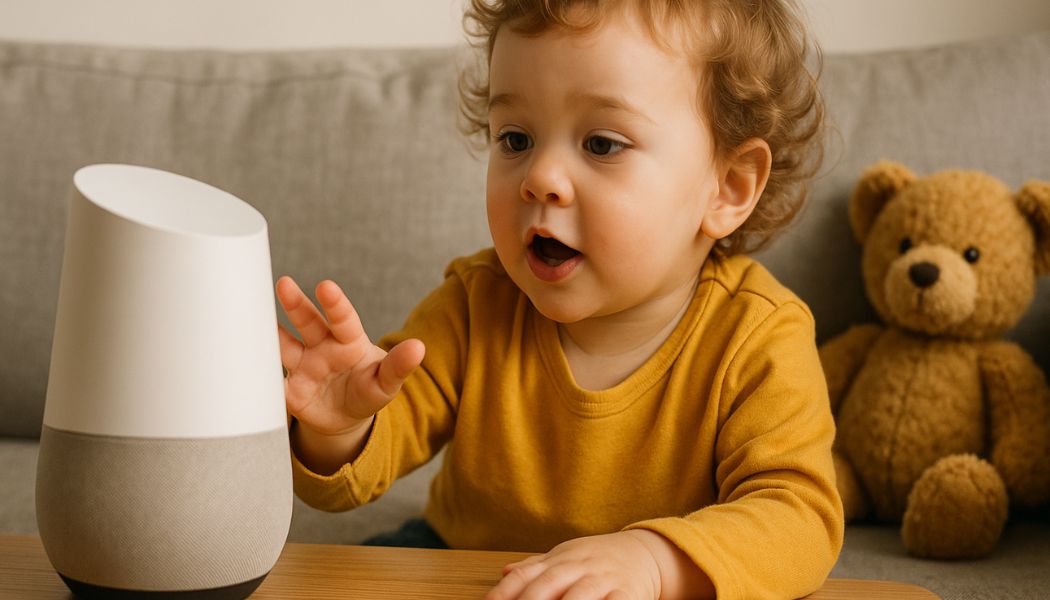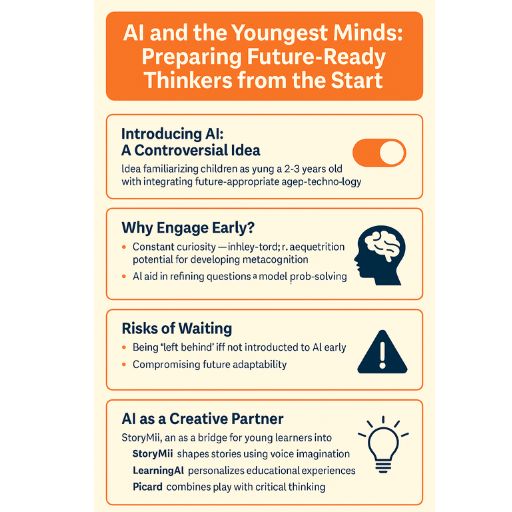AI and the Youngest Minds: Preparing Future-Ready Thinkers from the Start
A toddler asking Alexa to play “Wheels on the Bus” isn’t strange anymore. But here’s the real question: what if that moment isn’t just cute — what if it’s a critical learning opportunity?
As AI becomes foundational to how we live, learn, and work, the question we should be asking isn’t “When should kids start learning AI?”
It’s “Can we afford not to start early?”
And by early, we mean early childhood — even as young as two or three years old.
🧠 Early Brains Are Wired for Language, Emotion — and Now, Interaction
Neuroscience is clear: the first five years of life are a golden window for cognitive development. Children form over one million neural connections per second between birth and age five1. These years shape how children think, communicate, and adapt to the world around them.
So what happens when we introduce conversational AI, interactive storytelling, and emotionally responsive toolsduring this stage?
We help wire the brain not just to consume — but to collaborate.
🚼 But AI for Toddlers?! Isn’t That Too Much?
This may sound controversial. Let’s be honest: “AI for toddlers” can feel like a dystopian headline.
But we’re not talking about giving 2-year-olds ChatGPT prompts or robot tutors. We’re talking about:
- Voice-based storytelling tools that respond to curiosity
- Emotion-aware games that model self-regulation
- Playful AI-powered characters that adapt to how kids speak and move
Used thoughtfully, these tools don’t replace development — they support it. It’s a bit like how a child uses training wheels before learning to ride a bike on their own. The support is temporary, flexible, and fades as confidence grows. That’s the heart of scaffolded development: introducing just enough help to let children try something new — and step back as they begin to do it themselves.
StoryMii, for example, gives even the youngest learners a chance to shape stories using their voice and imagination — turning passive screen time into creative dialogue that helps build confidence, speech, and storytelling ability2.
✅ Why Start in Early Childhood? The Science Says: Start Before They Read
Here’s why this age group matters:
1. Language & AI Are Both Systems
Children in early childhood are immersed in learning how language works — and AI, at its core, is all about language interaction. Teaching kids how to “talk to” technology builds on the same cognitive muscles used for communication and comprehension3.
2. They’re Already Talking to Technology
If a preschooler can say, “Hey Google, what sound does a lion make?” — they’re already engaging with AI. The question is: do we leave this as a novelty, or do we turn it into guided, enriching interaction?
3. We Can Teach AI as a Thinking Partner
By age three, many kids ask over 200 questions a day. This constant curiosity is a sign that they’re beginning to understand how their own thinking works and how to improve it. That awareness, often called metacognition, is one of the most powerful learning tools a child can develop. When AI is used to help refine questions, model problem-solving, or reflect ideas back to a child, it supports that early sense of “I can figure this out — and I know how I’m figuring it out with the right questions”4.
According to a 2020 study published in Early Childhood Research Quarterly, introducing AI-assisted platforms in early education improves both language development and abstract reasoning in preschool-age children — particularly when the AI is used as part of interactive storytelling and question-based learning5.
4. Neurodivergent Kids Especially Benefit
For many neurodivergent children, especially those with speech delays, sensory sensitivities, or attention differences, AI-supported platforms can offer a kind of learning environment that is patient, responsive, and non-judgmental — something traditional settings often struggle to provide. Starting early gives these kids access to tools that can adapt to them, rather than expecting them to adapt to the system.
Research from UNICEF’s Global Framework on AI for Children also points to AI’s promise in making education more inclusive, especially when tools are designed to adapt in real time to the pace and preferences of young learners6.
🧰 Tools That Support AI Literacy in Toddlers (Without Replacing Play)
Let’s be clear: we’re not talking about coding classes for toddlers. We’re talking about playful, curiosity-driven experiences where AI enhances learning without taking center stage.
- StoryMii – Designed for ages 3+, this tool lets young children use their voice to tell stories and shape characters. It’s a perfect mix of creativity and feedback — helping kids connect their thoughts to outcomes in real time.
- Moxie by Embodied – A friendly, AI-powered robot designed for ages 4+, Moxie helps kids build emotional and social skills through conversations, storytelling, and daily challenges7.
- Cognimates (MIT) – While geared toward slightly older children, younger sibling pairs often engage with its simpler modules — watching how input leads to outcome, and experimenting with basic AI concepts through shared play8.
⚖️ Balancing Concerns: Can They Still Be Kids?
Absolutely — and they should be. The goal isn’t to have toddlers staring at screens for hours or outsourcing creativity to AI. It’s to use tools that feel like play, that encourage imagination, and that spark curiosity — not stifle it.
That’s where intentionality comes in. It’s not about giving a child any app just because it’s convenient. It’s about making mindful choices: choosing experiences that align with their developmental needs, building in adult support, and setting up technology as a co-pilot in learning — not the driver.
Intentionality asks us to treat AI not as a digital babysitter, but as an opportunity to elevate what children already do best: imagine, question, explore, and connect.
❓Can We Afford to Wait?
Just like our kids are now digital natives, we must help them become AI natives — not in a way that turns them into robots, but in a way that makes them empathetic, imaginative collaborators with intelligent systems.
If we wait until they’re older to teach them how to engage with AI, they’ll have already learned how to ignore it, misuse it, or fear it.
Instead, we can help them understand it, guide it, and use it — just like we did with books, with TV, with the internet.
Let’s raise a generation that can say:
“I can imagine it. I can ask questions about it. And I can help build it.”
Even if they're still in pull-ups.
📚 References
- Center on the Developing Child. (2007). “Brain Architecture.” Harvard University. Link ↩
- Neumann, M. (2018). “Young Children’s Use of Touch Screen Tablets for Writing and Reading at Home: Relationships with Emergent Literacy.” Computers & Education, 117, 37–48. ↩
- Bialystok, E. (2001). Bilingualism in Development: Language, Literacy, and Cognition. Cambridge University Press. ↩
- Flavell, J. H. (1979). “Metacognition and Cognitive Monitoring.” American Psychologist, 34(10), 906–911. ↩
- Falloon, G. (2020). “From Digital Literacy to Digital Competence: The Teacher Digital Competence Framework.” Early Childhood Research Quarterly, 53, 123–135. ↩
- UNICEF (2021). “Policy Guidance on AI for Children.” Link ↩
- Embodied, Inc. (2023). “Meet Moxie.” Link ↩
- Cognimates (MIT Media Lab). “AI Education for Kids.” Link ↩


